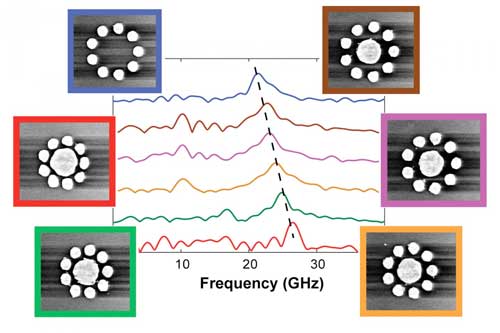| Posted: Oct 16, 2017 |
Vibrating nanoparticles interact
(Nanowerk News) Like a tuning fork struck with a mallet, tiny gold nanodisks can be made to vibrate at resonant frequencies when struck by light. In new research, Rice University researchers showed they can selectively alter those vibrational frequencies by gathering different-sized nanodisks into groups.
|
|
"In the tuning fork analogy, it would be as if we could alter the sounds of several forks by bringing them close together," said Rice nanoscientist Stephan Link, the lead researcher on a study in this week's Proceedings of the National Academy of Sciences ("Vibrational coupling in plasmonic molecules"). "But at the nanoscale, we do not hear a tonal shift; we instead see a tiny change in color. We've shown that by grouping nanodisks, we can shift their acoustic resonance in an orderly and predictable way, which could be useful in optomechanics."
|
 |
| Rice University scientists found they could selectively alter resonant frequencies (graph) of gold nanodisks by grouping them with slightly different placement and spacing. (Image: C. Yi/Rice University)
|
|
Optomechanics is a merged branch of physics, materials science and nanophotonics that focuses on the interactions between light and mechanical devices. Optomechanical systems are used in telecommunications, microscopy, quantum computing and sensors, including the laser interferometers that detected the first gravity waves in 2016.
|
|
Rice postdoctoral research associate Chongyue Yi and colleagues in Link's lab and the research group of Rice nanophotonics pioneer Naomi Halas created and tested more than a dozen sample groupings of nanodisks using electron beam lithography. Each group of tiny gold disks sat atop a flat surface called a substrate, which was sometimes ordinary glass and sometimes aluminum oxide. Yi, the study's first author, oversaw tests on nanodisks ranging in size from 78 to 178 nanometers in diameter, which were configured in patterns containing two to 12 disks.
|
|
Yi used two sets of laser beams to test the resonance of the groups. A pulse laser was used to strike the disks, which added a burst of energy analogous to the mallet striking the tuning fork. The light pulse provided an almost instant burst of heat, which caused the metal disks to expand and contract very fast, several billion times each second. A second laser beam was used to probe these vibrations by detecting tiny changes in their color in a microscope. The color was due to surface plasmons, coherent oscillations of conduction band electrons, which experienced intensity fluctuations with the frequency or speed at which the disks expanded and contracted.
|
|
Link and Yi's experiments showed the resonant frequency of smaller disks shifted about 20 percent when they were placed near larger disks. In collaboration with theorists at Rice and the University of Melbourne, the researchers determined that the acoustic vibrations from larger particles were traveling through the substrate to modify the resonances of smaller particles. To test this explanation, Yi conducted further experiments to show he could predictably alter the vibration frequencies of his samples by varying their size and distance as well as the surfaces to which they were attached.
|
|
"It really depends on what substrate we are using," Yi said. "With glass, the frequency change is larger than with aluminum oxide. Glass is softer. If the material is more stiff, it is harder to make it vibrate."
|
|
Link said the research points to a new way for engineers to convert light energy into mechanical energy and vice versa at the nanoscale.
|
|
"This gives us a new knob for precise tuning of the light output from metallic nanostructures," he said. "It opens the door for new applications in secure communications, sensing and more."
|

